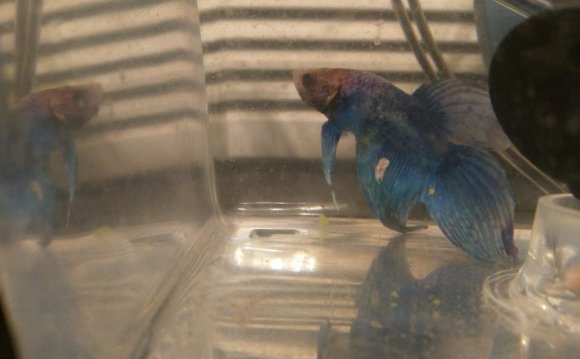
You've likely heard the well-known proverb, "The eyes are the window to the soul". This actually is a particularly appropriate phrase when diagnosing fish health problems. Very often, the first sign of an external disease in fish shows up as a change in their eye's structure, color, clarity or shape. It is not so much that the fish's eyes are affected by disease first, just that early changes in the outer body of a fish often show up better on the clear tissue of the fish's eye. Knowing how these eye changes can be used to diagnose fish diseases is a very helpful technique in an aquarist's arsenal of fish disease diagnostic tools.
How fish use their eyes
Obviously, fish use their eyes in basically the same manner as any vertebrate. Light enters the eye, is focused by the pupil, and falls on a receptor that makes an image that is then sent to the fish's brain where it is interpreted. Water has a different specific gravity than does air, so a fish's focus adapts to that, and they cannot see clearly out of the water. One exception to this rule is the four-eyed fish, (Anableps sp.). This unusual fish has a split eye - the lower part is adapted to focusing underwater, while the top half has a different focal point and allows the fish to see possible predators in the air above the water's surface where it lives.
Many fish have their eyes on either side of their head (Flatfish, soles and flounders excluded). This works to their advantage in being able to see clearly both to the left and right of their body from almost in front of them to almost directly behind. However, these two separate signals mean that the fish must process two images at the same time, and they lack depth perception because there is little or no overlap in the image they receive. Predatory fish require depth perception in order to capture their prey, so their eyes are either placed more forward on their head, or their pupils are elongate, allowing them to have a greater range of depth so that they can more easily judge the distance of potential prey items. The lack of depth perception in many fish can be used to the aquarist's advantage; capturing a fish can often be more easily accomplished by using two nets, and coming at the fish from two different directions at once. The fish is unable to adequately process the visual information coming at them from two directions, gets confused, and can be netted much more easily.
In some fish, like this Comet, it is difficult to even see their eyes.
Aquatic environments are not always conducive for the use of eyes to receive and interpret visual signals. Fish have problems seeing in murky water, or at night. The flashlight fish overcomes the latter problem by having pockets of luminescent bacteria in special light organs beneath each eye. They can use the light from these bacteria to see their prey at night, and also to confuse potential predators (Hemdal 1986).
Fish lack eyelids (although sharks and some other fish have a nictitating membrane that they can close over their eyes to avoid mechanical damage). Fish also seem to lack a rapidly responding iris to quickly limit the amount of light entering the pupil. For these two reasons, fish are unable to adapt to rapid changes in light levels, and some species may react to such a change by going into systemic shock if the light level changes too quickly. Since this shock reaction cannot easily be predicted by aquarists, it is always best to slowly ramp up the lighting in an aquarium so the fish are not startled by a sudden change in intensity. Additionally, since they do not have eyelids, diurnal fish (those active during the day) should be given a mostly dark aquarium at night so that they can receive a proper amount of "down time" that functions as their sleep mechanism. Although fish can survive under "24/7" lighting for long periods, (personal observation) it is prudent to avoid such constant lighting in order to reduce overall stress levels in the fish.









